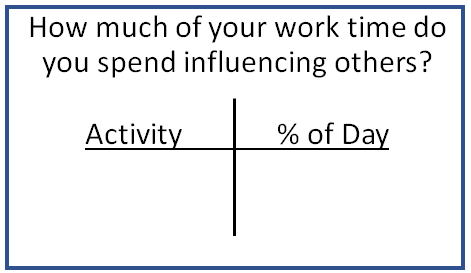When I teach my class “Leading through Influence,” I always begin with the same exercise, shown in Figure 1. Its purpose is to help my students understand how much time they spend each day trying to influence people to complete the tasks they have already been asked to perform. You can do this for yourself using the worksheet at the end of this chapter.
When the class completes this exercise, the time spent on influence-related activities is noted to be generally between 20 and 75 percent, depending upon job type. Sales professionals, project managers, relationship managers, administrative staff, and managers/executives of all types tend to be in the 50 to 75 percent range. On the lowest end at 5 to 25 percent are people in heads-down, transaction-oriented jobs, such as programmers, accounting staff, and those in operational or process type roles. The general correlation is: the more the role requires dealing with people, the higher the percentage of each day that person will spend trying to influence others.
ROI #1: Personal Productivity
For the sake of argument, let’s say that 25 percent of your day is spent trying to influence other people to do the tasks they’ve been assigned. If learning about influence could cut that time in half to 12.5 percent of your day, then based on an eight-hour day, you would save one hour a day, providing you use that time to do other things. Yes, that’s five hours per week of reclaimed productivity. This time could be used to perform other important tasks or simply leave the office in time to watch your child’s after-school soccer game.
ROI #2: Enhanced Work Quality
Another advantage of studying influence is it makes it easier to get what you need to perform your job. This could be allocation of money/budget, getting the best people to work on your project, receiving favorable terms from a vendor, or having access to important information. Collectively, these items and others like them allow you to increase the quality of your projects, and they provide you with the opportunity to create your highest quality work.
ROI #3: Reduced Project/Task Risk
Continuing on the theme described in RIO #2, if your project is well funded and has the best possible people, information, and vendor support, these factors increase the chances of success by reducing the overall risk. This reduced risk is advantageous to your company, your department, and, ultimately, you personally.
ROI #4: Enhanced Job Performance
If you are more productive (ROI #1), your work quality is higher (ROI #2), and your projects/tasks are more likely to succeed (ROI #3), then, logic would dictate, the influence you wield has a positive effect on your overall job performance.
ROI #5: Positions You for Future Promotion Opportunities
In addition to the value to the company of the previously stated ROIs, your ability to influence others also helps position you for future career advancement. This is achieved by the combination of:
- Illustrating your ability to lead your peers and others toward a desired objective.
- Showing your ability to get things done.
- Generating great business results.





